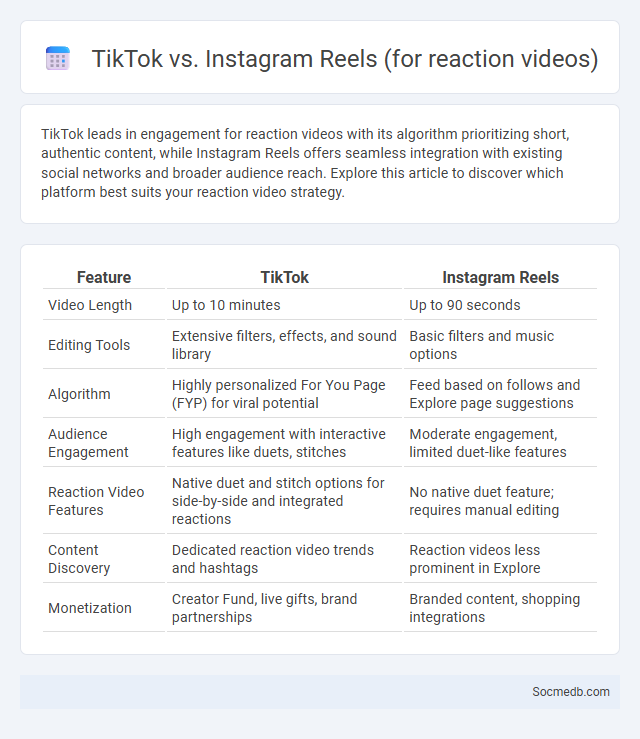
Photo illustration: TikTok vs Instagram Reels (for reaction videos)
TikTok leads in engagement for reaction videos with its algorithm prioritizing short, authentic content, while Instagram Reels offers seamless integration with existing social networks and broader audience reach. Explore this article to discover which platform best suits your reaction video strategy.
Table of Comparison
| Feature | TikTok | Instagram Reels |
|---|---|---|
| Video Length | Up to 10 minutes | Up to 90 seconds |
| Editing Tools | Extensive filters, effects, and sound library | Basic filters and music options |
| Algorithm | Highly personalized For You Page (FYP) for viral potential | Feed based on follows and Explore page suggestions |
| Audience Engagement | High engagement with interactive features like duets, stitches | Moderate engagement, limited duet-like features |
| Reaction Video Features | Native duet and stitch options for side-by-side and integrated reactions | No native duet feature; requires manual editing |
| Content Discovery | Dedicated reaction video trends and hashtags | Reaction videos less prominent in Explore |
| Monetization | Creator Fund, live gifts, brand partnerships | Branded content, shopping integrations |
Introduction: Rise of Reaction Videos
Reaction videos have surged in popularity across platforms like YouTube and TikTok, capturing authentic emotional responses to various content types. This trend leverages human curiosity and emotional connection, driving high engagement and viewer retention rates. Your participation in sharing reactions can amplify reach and foster community interaction within social media ecosystems.
TikTok vs Instagram Reels: Platform Overview
TikTok boasts a massive global user base exceeding 1 billion active users, driven by its algorithm that promotes viral content and creative trends. Instagram Reels, integrated within the Instagram app with over 2 billion monthly active users, leverages Facebook's broader ecosystem to attract established audiences and brands. Your choice between TikTok and Instagram Reels should consider engagement rates, target demographics, and content style preferences for optimal social media strategy.
Algorithm Differences for Reaction Video Discovery
Social media platforms like YouTube, TikTok, and Instagram utilize distinct algorithms that prioritize reaction video discovery differently; YouTube emphasizes watch time and user engagement, boosting videos with higher retention rates and comments. TikTok's algorithm leverages AI-driven content recommendation based on user interaction patterns such as likes, shares, and replays, enabling viral potential for reaction videos. Instagram focuses on recent engagement and relationships, highlighting reaction content in users' feeds through its Explore page and Reels feature, favoring creators with strong follower interaction.
Content Creation Tools: TikTok vs Reels
TikTok offers an extensive suite of content creation tools, including advanced video editing features, AI-powered effects, and a vast music library that caters to viral trends, enhancing user engagement. Instagram Reels provides seamless integration with Instagram's platform, featuring user-friendly editing tools, augmented reality filters, and direct sharing options to Stories and Feed, boosting content visibility within existing follower networks. Both platforms emphasize short-form video content but differ in community dynamics and algorithmic exposure, influencing creator strategy and audience reach.
Audience Engagement: Which Platform Wins?
Facebook leads in audience engagement with over 2.9 billion active users, offering diverse interactive features like groups, live videos, and stories that boost user participation. Instagram follows closely, especially popular among younger demographics, with high engagement rates driven by visual content and influencer interactions. Your choice depends on targeting specific audiences; Facebook suits broad, diverse groups, while Instagram excels for brands focusing on visual storytelling and millennials or Gen Z.
Monetization Opportunities for Reaction Videos
Reaction videos on social media present significant monetization opportunities through platforms like YouTube, which offer ad revenue sharing programs such as YouTube Partner Program. Content creators can increase earnings by integrating brand sponsorships, affiliate marketing links, and fan donations during live streams. Utilizing SEO strategies and trending topics optimizes visibility, driving higher viewer engagement and boosting revenue potential from reaction-based content.
Video Editing Features Compared
Video editing features on social media platforms vary in complexity and accessibility, with TikTok leading in user-friendly effects and seamless integration for short-form video creation. Instagram offers robust tools like Reels with trimming, filters, and audio syncing, catering to both casual users and content creators. YouTube stands out with advanced editing options in YouTube Studio, providing multi-layered editing and customizable enhancements suited for long-form content.
Copyright & Fair Use Policies
Social media platforms enforce strict copyright and fair use policies to protect original content creators and prevent unauthorized distribution. Users must understand that reposting, sharing, or modifying copyrighted material without explicit permission can lead to account suspension or legal consequences. Platforms like Facebook, Instagram, and YouTube rely on advanced content identification technologies to detect copyright infringement and uphold intellectual property rights.
Trends in Reaction Video Popularity
Reaction videos have surged in popularity on platforms like YouTube and TikTok, driven by audiences seeking authentic emotional responses to trending content such as music releases, movie trailers, and viral challenges. Your engagement with these videos reflects a growing trend where viewers prefer real-time, relatable commentary that fosters community interaction and shared experiences. The evolving algorithmic preference for reaction content highlights its rising influence in shaping social media consumption patterns and digital marketing strategies.
Final Verdict: Best Platform for Reaction Videos
TikTok emerges as the best platform for reaction videos due to its powerful algorithm that promotes viral content and user engagement. With its short-form video format and a vast audience base, creators can quickly gain visibility and foster a community around reaction content. YouTube also supports reaction videos effectively, offering monetization options and longer format flexibility for in-depth responses.
 socmedb.com
socmedb.com